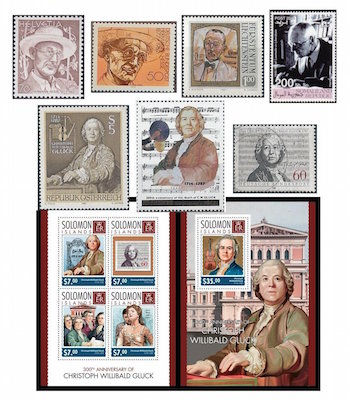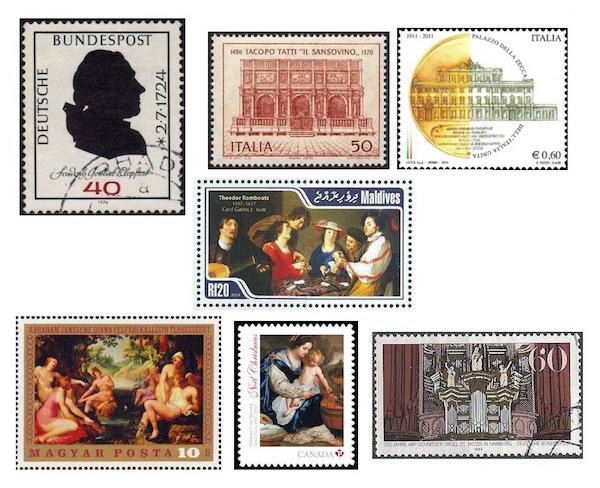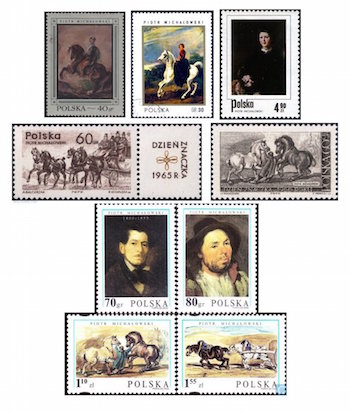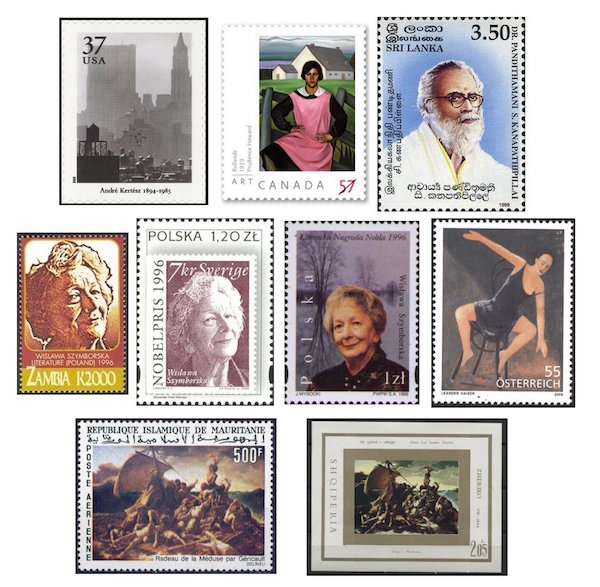The Arts on Stamps of the World — July 2
An Arts Fuse regular feature: the arts on stamps of the world.

By Doug Briscoe
July 2nd is the birthday of Nobel Prize winners Hermann Hesse and Wisława Szymborska, German composer Christoph Willibald von Gluck, and one of the most important organ builders, Arp Schnitger.
Since our plate is rather full today, I’ll gloss over Hermann Hesse (2 July 1877 – 9 August 1962), who is already so well known to Arts Fuse readers, except to indicate the provenance of his four postage stamps: Germany and Switzerland, as you might expect, Liechtenstein, and the Somaliland Republic, as you mightn’t.

Christoph Willibald von Gluck (2 July 1714 – 15 November 1787) was a seminal composer of 49 operas, whose reforms of the genre influenced generations of composers. His greatness was recognized in his own time, and he was much in demand all over Europe. Born in Bavaria, the much-travelled composer studied with Sammartini in Milan, saw his first opera produced there (1741), wrote operas for Turin and Venice, moved on to London, Dresden, Vienna, where he settled, Copenhagen, Prague, and Paris, where conniving impresarios set up a rivalry with the Italian composer Niccolò Piccinni (not to be confused with Puccini); but as with the Brahms/Wagner controversy of the next century, the composers themselves respected each other and did not take part in the contretemps. When Gluck died, Piccinni even proposed that Gluck be honored with a public monument, but the strongly partisan Gluckists rejected the idea. (“What, give the other side the credit? We’d rather die!” Sound like any congressmen you know?) His most famous opera is Orfeo ed Euridice (Orpheus and Eurydice), from which many people know the instrumental Dance of the Blessed Spirits with its prominent flute solo. I also recommend his ballet Don Juan, recorded complete by both Neville Marriner and John Eliot Gardiner, which to my ear has a memorable tune in just about every number. Gluck stamps from Austria and Germany are only to be expected, but it may surprise you to see a pair of souvenir sheets from the Solomon Islands (issued in 2014 for the composer’s tricentennial) and a stamp from North Korea! (This last comes from a 1987 set devoted to five Western musicians and one North Korean, Kim Ok-song, whose birthday was just the day before yesterday.) Several other nations, the Central African Republic, the Republic of Guinea, and Togo, issued sheets for the tricentennial.
Among the song settings of Gluck are several using the poetry of his countrymen and birthday fellow Friedrich Gottlieb Klopstock (1724– March 14, 1803). Many of the works of this poet were set by Franz Schubert, who wrote more than a dozen Klopstock songs and partsongs in the years 1815-16 but also used the poet’s version of the Stabat Mater adapted from Jacopone da Todi (Schubert’s D. 383, also dating from 1815, a major work of some 38 minutes’ duration for soloists, chorus, and orchestra). Klopstock also inspired many second-tier composers of his time, including Joseph Martin Kraus (whose stamp I displayed here just days ago), Maria Theresia von Paradis, Hans Georg Nägeli, Ries, and Lachner. Composers of greater note who put Klopstock’s verses to music include Fanny Mendelssohn, Schumann (a chorus for men’s voices), and Loewe, and, in later years, Richard Strauss, Hindemith, and Krenek. The poem “Das Rosenband” has been a particular favorite, with settings by Kraus, Zelter, Schubert (D. 280), MacDowell, Strauss (Op. 36 #1), Karl Weigl, and Zemlinsky. But surely the most famous and greatest music inspired by Klopstock is the finale of Mahler’s “Resurrection” Symphony. At the funeral of Hans von Bülow Mahler heard a setting of Klopstock’s “Die Auferstehung” and at once found the material he had been seeking for the finale of his Second Symphony. He used the first two verses from Klopstock (modified) and wrote the remaining lines himself. The German stamp was issued on the occasion of the 250th anniversary of the poet’s birth.
In large part we have Italian architect Jacopo Sansovino (2 July 1486 – 27 November 1570) to thank for the appearance of Venice’s Piazza San Marco. He was responsible for creating a few of the buildings in and around the square along with numerous accompanying sculptures and reliefs. In the square itself, at the base of the famous Campanile, is the Loggetta (completed 1549). This structure was chosen for the stamp honoring Sansovino on the 400th anniversary of his death. The building was destroyed when the campanile collapsed in 1902; the reconstruction was complete by 1912. The more recent stamp (2011) shows Sansovino’s public mint, or Zecca (1536-1545). The artist’s masterpiece is considered to be the Library of Saint Mark’s, the Biblioteca Marciana in front of the Doge’s palace. With his echoing of the classical style, Sansovino altered the rather more florid architectural tastes of the Venetians and thus paved the way for his successor Andrea Palladio. Born Jacopo Tatti in Florence, he took the name of his first master Andrea Sansovino and was also active in Rome before being named chief architect and superintendent of properties to the Procurators of San Marco.

Flemish painter Theodoor Rombouts (2 July 1597 – 14 September 1637) of Antwerp was in Rome from 1616 to 1625, but he had already imbibed the influence of Caravaggio from his master Abraham Janssens. Most of the work of Rombouts comprises genre pieces such as his rather wry Lute Player and Card Game (c1620), as seen in the stamp from the Maldives, though he also did some biblical and mythological paintings. Now since we have taken the name of Abraham Janssens (1575–1632), let us not do so in vain. As we don’t know the exact dates of his birth and death, I thought I’d take this opportunity to show a couple of his works on stamps: Diana and Callisto (1601) on a stamp from Hungary and a Madonna and Child on a Canadian Christmas stamp. He often signed his work “Janssens van Nuyssen”.
Our next artist was neither born nor died on July 2nd either, but he was buried on that date in 1719. The famous and prolific German organ builder Arp Schnitger was born in 1648. “The importance of Schnitger to the history of organ building cannot be overestimated”, says Wikipedia. The stamp was issued in 1989 to commemorate the 300th anniversary of what is perhaps Schnitger’s best known organ, the one at St. James’ Church (St Jacobi) in Hamburg. (Actually, the work was begun in 1689 but not completed until 1693, and was a modification of an already existing organ made in 1635 by Hans Christoph Fritzsche [b. before 1638, d.1674]). Again, to quote Wikipedia, “The church was very badly damaged in the bombing of Hamburg in World War II, but the pipes of the organ had been removed and stored for safekeeping. The original case, however, remained in the church and was destroyed. The reconstructed version of the original was re-dedicated in a church service on January 19, 1961.”
As can be seen from the array of stamps, Polish Romantic painter Piotr Michałowski (July 2, 1800 – June 9, 1855) specialized in portraits and oil studies of horses. Son of a landowner and senator, Piotr had encouragement and tutelage for his budding talent from professional artists from the age of 13. He broadened his education at the Jagiellonian University, learning philosophy, agriculture, mathematics, and all the usual kinds of troublesome, woolly-headed, upset-the-natural-order-of-things, progressive nonsense that got him involved with the November Uprising of 1830. When that failed he fled with his wife to Paris, where he studied under Charlet and made a big splash with the art-buying public. He returned to Poland in 1835. All the stamps are Polish, and among them are, in the upper row, Knight on Bay Horse, Artist’s Daughter on Horseback (1853), and The Artist’s Son Tadeusz (c1840; I provide a link because the stamp image is so dark); Stableboy Bridling Percherons (second row right and again at bottom row left), and Self-Portrait (c1850, third row left).

Born in Budapest on 2 July 1894 to a middle-class Jewish family, Kertész Andor, as he was then called, sold his first photographs to magazines in 1917 while he was still serving in the Hungarian army. Wounded in 1915, he had suffered a temporary paralysis of his left arm and didn’t recover sufficiently to return to the front. In Paris from 1925, Kertész sold pictures to various European magazines. It was at this time that he Westernized his name to André Kertész. Apparently he was among the first photographers to have a one-man show (1927). One of the projects that exemplified his unorthodox approach to photography is declared in the very title of his 1933 book Distortions. He and his wife emigrated to the United States in 1936 and became citizens in 1944. Underappreciated, Kertész worked on into his nineties and died on 28 September 1985. The stamp comes from the same sheet as the one for James Van DerZee we saw a few days ago. Each stamp has an accompanying text on its reverse, and the one for Kertész reads: “By combining simple, personal observation with compassionate interest in the human condition, Hungarian-born André Kertész…made carefully balanced yet spontaneous photographs infused with the appealing brightness and wit he found in the urban experience. The dramatic play between pattern and deep space in this New York cityscape reveals Kertész’s mastery of complex composition.” Snooze.
The bold work of Canadian painter Prudence Heward (July 2, 1896 – March 19, 1947) is exemplified by her Rollande of 1929. Born to a comfortable Montreal family, Heward was serving in the Red Cross while her “enemy” Kertész was in the trenches or recovering from his wound. Her paintings were shown in 1924, but her first solo exhibition had to wait until 1932. Like Kertész, she went to Paris in 1925; unlike him, she got to meet Hemingway and Fitzgerald. Much of her canon is given over to strong portraits—she preferred the word “figures”—of women, such as Girl in a Yellow Sweater and Negress with Flower (both 1936).
Tamil author Kandasamypillai Kanapathypillai (2 July 1902 – 1968) was born in northern Ceylon. After studies there and in India, he earned a PhD in linguistics from the University of London in 1935. A scholar on Tamil, he translated ancient inscriptions as well as writing plays and novels in the language.
Exactly fifty years separate the Nobel Prizes in Literature won by Hermann Hesse (1946) and Wisława Szymborska (vee-SWAH-va shim-BOR-ska; 2 July 1923 – 1 February 2012). During World War II she worked as a railroad employee and just before the war ended published her first poem. She became involved with writers and met Czesław Miłosz, whose stamps we saw on Friday. She was content to work within the Communist system until the mid-to-late 1950s, when she began to establish relationships with dissidents, rejecting her earlier political work and finally quitting the party in 1966. Szymborska also translated poetry from the French, concentrating on works of the 17th and 18th centuries. The final film of Krzysztof Kieślowski’s Three Colors trilogy, Red (1994), was inspired by Szymborska’s poem, “Love At First Sight”. Zambia honored Szymborska with a stamp when she won the Nobel Prize in 1996. One of the two Polish stamps simply took the Swedish stamp design (issued on the same occasion) and repackaged it within a larger Polish frame, and that saves me the trouble of including the original Swedish image.

The only one of our subjects today who is still living is Austrian painter Leander Kaiser, born in 1947 in Innsbruck. While still in his teens he saw some of his illustrations published in book form. He attended the Academy of Fine Arts Vienna but left it to pursue studies in sociology and philosophy, turning later to Marxism. But politics do not seem to have encroached on Kaiser’s cheery painting, two dozen examples of which you may see on his website, or you may be content with one, Woman Rocking on a Chair (n.b., not “Woman on a Rocking Chair”) on the stamp from 2009.
A tragedy that occurred 201 years ago today inspired a great painting and numerous other works of art in various forms. On July 2, 1816 the French frigate Méduse ran aground. The crew built a raft with which to unload the heavier cargo so that the ship might be coaxed off the bank, but when a sudden storm came up all but 17 of them abandoned ship and boarded the raft or lifeboats. The sequent events do not show human nature at its best. Fearful that their lifeboats might be overcrowded, some of the crew cut the ropes to the raft. Murder, suicide, and cannibalism claimed the lives that nature didn’t, and after an ordeal of two weeks only 15 of the men on the raft survived. The disaster struck 25-year-old Théodore Géricault, who painted one of his finest masterpieces, The Raft of the Medusa, a couple of years after the event. Later treatments include a 1943 play by German dramatist Georg Kaiser, a 1968 oratorio composed by yesterday’s birthday subject Hans Werner Henze, and a 1994 film, Le Radeau de la Méduse, by Iradj Azimi. I show a couple of stamps that depict Géricault’s painting.
A graduate of the University of Massachusetts with a B.A. in English, Doug Briscoe worked in Boston classical music radio, at WCRB, WGBH, and WBUR, for about 25 years, beginning in 1977. He has the curious distinction of having succeeded Robert J. Lurtsema twice, first as host of WGBH’s weekday morning classical music program in 1993, then as host of the weekend program when Robert J.’s health failed in 2000. Doug also wrote liner notes for several of the late Gunther Schuller’s GM Recordings releases as well as program notes for the Boston Classical Orchestra. For the past few years he’s been posting a Facebook “blog” of classical music on stamps of the world, which has now been expanded to encompass all the arts for The Arts Fuse.
